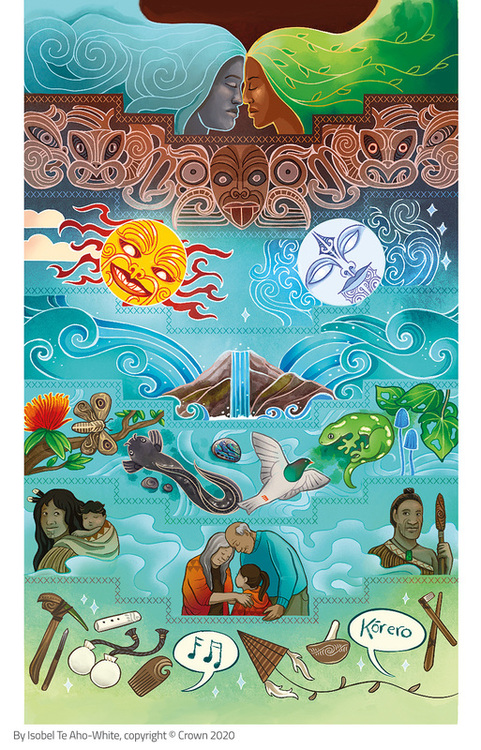Te Tatauranga o ngā Manu Māra o Aotearoa | New Zealand Garden Bird Survey strives to encourage kaitiakitanga through citizen science efforts to enhance knowledge and awareness of both native and introduced bird species. The valuable data that is collected nationwide plays a crucial role in monitoring and understanding the status of bird populations in Aotearoa, promoting community involvement in conservation and guiding efforts to safeguard biodiversity in urban and suburban areas.
Connections to living and non-living things
Iwi Māori consider everything living and non-living to be interconnected. Whakapapa describes these connections and uses various mediums to tell the story of how people, the landscape, plants and animals came into the world. People, plants and animals are all descendants of Ranginui and Papatūānuku. Their children – humans – are therefore intrinsically linked with biodiversity. The concepts of mauri, mana, tapu and wairua are important to consider in relation to both people and nature.
As tangata whenua, we have a role as kaitiaki to preserve the mauri, wāhi tapu and natural taonga in our respective areas. Kaitiakitanga includes active stewardship or guardianship of the land, with Māori traditionally having their own system of resource management to sustain people and natural resources for the future. The relationship between the health of the ecosystem and the wellbeing of the people can be demonstrated by this whakataukī:
Ko ahau te taiao, ko te taiao, ko ahau.
The ecosystem defines my quality of life.
Observation and preservation
The annual New Zealand Garden Bird Survey is a citizen science initiative that provides opportunities for ākonga to participate in a simple bird-watching activity that connects them to nature and enables them to become citizen scientists. It can be done as a class and/or home activity.
The key objectives of this survey include:
- monitoring bird populations by tracking changes over time and providing valuable data for conservation efforts
- engaging with the public by raising awareness about local bird species and their ecological roles while fostering a connection between people and nature
- collecting data for scientific research on bird population trends and habitat health.
Resources to support Te Tatauranga o ngā Manu Māra o Aotearoa
We have developed a suite of resources for kaiako and tauira to immerse themselves in learning, understanding and acknowledging the birdlife in our environment. These informative resources were created to inspire, enlighten and extend learning for our tamariki.
Te Tatauranga o ngā Manu Māra o Aotearoa
This article is part of a suite of resources for kaiako and tauira to immerse themselves in learning, understanding and acknowledging the birdlife in our environment. Other resources include:
- Manu – past, present and future
- Bird adaptations and identification
- Te Tatauranga o ngā Manu Māra o Aotearoa – exploring data
- Taking action for our birds
- Yvonne Taura (kairangahau Māori)
- Milly Grant-Mackie (kairangahau Māori)
Related content
The PLD article New Zealand Garden Bird Survey – a context for learning provides additional background information about the survey and links to a variety of resources.
Learn how the decline of bird populations in Aotearoa is impacting pollination and seed dispersal.
Join the students of the Kids Restore the Kepler project as they work together to complete their mission: to bring birdsong back to the Kepler Track. This collection curates resources for your students to bring back the birdsong in your own local environment. You can copy the collection and customise it to suit your needs.
Learn about how birds are categorised as endemic, native or introduced.
Useful links
Visit the New Zealand Garden Bird Survey website for additional resources.
Visit the Environment Foundation website for information about Māori and biodiversity.
Acknowledgement
This resource has been produced in collaboration with Manaaki Whenua – Landcare Research and the New Zealand Garden Bird Survey.




